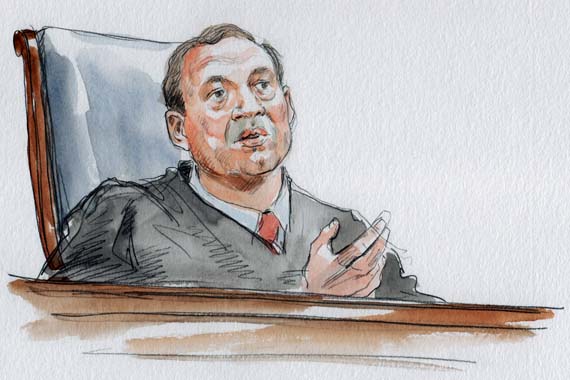The court is likely to uphold Biden’s “ghost guns” regulation
ARGUMENT ANALYSIS
The Supreme Court on Tuesday appeared ready to uphold a 2022 federal rule regulating so-called “ghost guns” – untraceable weapons without serial numbers, assembled from components or kits that can be bought online. (Katie Barlow)
The Supreme Court on Tuesday appeared ready to uphold a 2022 federal rule regulating so-called “ghost guns” – untraceable weapons without serial numbers, assembled from components or kits that can be bought online.
Defending the rule, U.S. The ATF adopted the rule in response to what it calls an “exponential increase” in ghost guns. It cited the Gun Control Act which, among other things, requires gun manufacturers and dealers conduct background checks and maintain records of gun sales. The rule defines a “firearm” as any product that can be transformed into a functional gun, or if it is a functional receiver or frame (the basic structure or the gun), or if it is able to be converted from. The rule clarified that “frame” and receiver” includes partially completed or disassembled receivers or frames that can be “readily converted” to work as a receiver or frame. U.S. District judge Reed O’Connor agreed and banned the agency from enforcing the rule anywhere in America. The conservative U.S. Court of Appeals, 5th Circuit, largely upheld this decision. The Biden administration then went to the Supreme Court to ask permission to enforce the rule during its appeal. The Supreme Court allowed this rule to stay in place by a 5-4 vote, with Justices Clarence Thomas and Samuel Alito voting against the request. Brett Kavanaugh, Neil Gorsuch and Brett Kavanaugh also voted against the ruling. She said that the manufacturers had advertised their products as “ridiculously easy to assemble and dummy proof” and claimed you could have a fully functioning gun in 15 minutes. No serial number, background checks, or records were required. In fact, she noted, she herself had put one together.
Justice Clarence Thomas pressed Prelogar on the government’s argument that the 2022 rule is consistent with the ATF’s past practice. She acknowledged that the new rule now considers tools to assist in drilling, but it also “goes directly to the question that the agency has asked all along, namely, how quickly, easily, and efficiently” can the process of making the item a functional gun “be completed”? And although the new rule now considers tools to assist in drilling, she acknowledged, that too “goes directly to the question that the agency has asked all along, namely, how quickly, easily, and efficiently” can the process of making the item a functional gun “be completed”?
Justice Neil Gorsuch asked Prelogar about a point that Patterson and the challengers also made – the idea that the 1968 law defines “firearm” as a weapon that will “or may readily be converted to expel a projectile” but does not contain the same language for frames or receivers.
It would be “very odd,” Patterson suggested, for the rule to apply to frames or receivers that “may readily be converted” to function as a framer or receiver when Congress did not use that same language in defining frames or receivers in the 1968 law.
Prelogar countered that such an interpretation was the best way to make sense of the 1968 law. She said that Congress was trying to cover frames and receivers which are already functional “at the time they’re sold”, but also “framers and receivers which can be easily converted to function” with minimal steps. And if there is only one difference between them, then it is no different than a bicycle that doesn’t have pedals. Otherwise, she told the justices, gun manufacturers can get “avoid the regulation and the essential requirements of serializing, background checks, and recordkeeping just by leaving one little part of the weapon or the frame or receiver unfinished.”
Patterson countered that the law could only apply to complete frames or receivers. He continued that even if incomplete frames or receives are covered by the law, the standard would not be whether they could be “readily transformed” into frames or receivers. Instead, it would be what he called the “critical machining operation” standard used by the ATF previously. Roberts was skeptical about Patterson’s claim that hobbyists interested in building their own guns are the target market for partially completed frames and receivers. Roberts questioned if someone who went through the process to drill the one or two small holes and remove the plastic would really think that they had built the gun. Instead, she suggested, “it’s just sort of a way of allowing for a de minimis exception, right?”
Justice Brett Kavanaugh expressed concerns similar to those that he had voiced earlier this year at the oral argument in the challenge to an ATF rule that banned bumpstocks. Kavanaugh asked what about a gun dealer who may not be aware that he’s violating the new rule. Would he still face criminal charges?
Prelogar noted that if a manufacturer believed in good faith that it was not violating the law, it could not be convicted for failing to put a serial number on the gun or for selling the gun without a license. And although the standard was different for someone who failed to conduct a background check before selling a ghost gun, she continued, she suggested that the government was not “likely to charge someone in that kind of situation.” And in any event, she added, that situation was different from those in which “the manufacturers were themselves the sellers putting these products on the market with explicit knowledge that it was being put into the hands of teenagers.”
In her rebuttal, Prelogar again emphasized the possible effects of striking down the rule. Reiterating that the challengers’ “primary argument” is “that a single undrilled hole is enough to exempt a product from regulation,” she told the justices that the court “doesn’t have to blind itself to the practical ramifications” of that argument.
This article was originally published at Howe on the Court.






